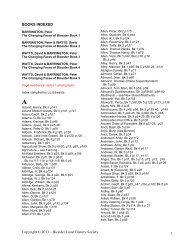Draft Bicester Conservation Area Appraisal November 2009
Draft Bicester Conservation Area Appraisal November 2009
Draft Bicester Conservation Area Appraisal November 2009
You also want an ePaper? Increase the reach of your titles
YUMPU automatically turns print PDFs into web optimized ePapers that Google loves.
Home Farmhouse7.5 In the 18th and 19th centuries, MarketHill and Church Street were the fashionableparts of town and the emerging middleclasses built their homes here. Forexample no.4 Market Hill is early 18thcentury date, of 3 storeys with a symmetrical5 window front of chequer brick, partof which is now incorporated into the adjacentsupermarket. No. 1 ClaremontHouse, is a rendered 3 storey buildingwith attic and elaborate timber detailing.No. 5 <strong>Bicester</strong> Hall, is a 3 storey doubledepth plan house with a 5 window front.Further out of town, no. 17 The Hermitageand 17a were originally one dwelling andare of additional interest as the old gaol isattached to no. 17.At Church Street, no. 18 NorthamptonHouse is a mid 18th century house with asymmetrical 4 window front and no. 20The Limes, is a substantial mid 18th century3 storey house with a 5 window front.At King’s End, Oxford House is a substantialearly 18th century house with a hippedslate and plain clay tile roof.Sheep Street looking north227.6 Buildings dating from this period but ofmore modest proportions can be foundfurther along Sheep Street. A notablegroup are no’s 24-30. No. 24 is theearliest, having a datestone is 1689 butthe others are 18th century of renderedlimestone and slate roofs. Further alongThe Bell Inn and adjacent properties no’s86-88 date from the early 18th century,and share a massive brick chimney stack.Manor Farm House and Home Farmhouseat Kings End date from the 17thcentury and both have slated woodenporches with flanking settles.Methodist Church7.7 Following the fire at Chapel Streethouses were cleared and in 1728 theCongregational Chapel was constructed,later extended in the 19th century. It is oflimestone rubble and chequer brick withashlar dressings and round archedwindows with tracery.Other chapels in the town include thechapel built by the Methodists in 1841 inNorth Street, now known as Weyland Hall,with school room added in 1885 and laterextensions of 1892. The early 20thcentury Wesley Hall and Wesley Cottageswere purchased from the UnitedMethodist Free Church members, whobuilt the chapel in 1863. Subsequently anew church was constructed on the northside of Sheep Street and opened in 1927.The Roman Catholic Church of TheImmaculate Conception in Causeway wasconstructed in 1963 in Italianate style.St Edburg’s Hall, London Road, wasdesigned in 1882 by the architect E.G.Bruton.



